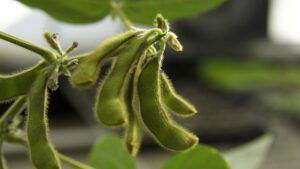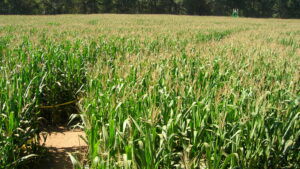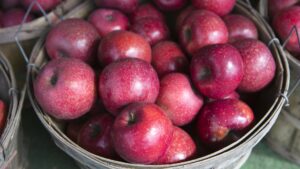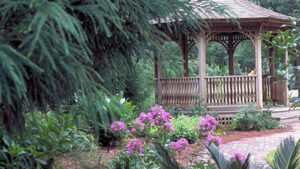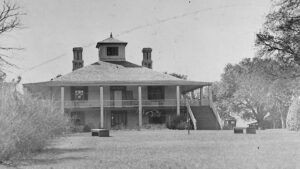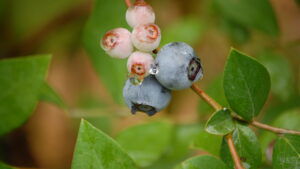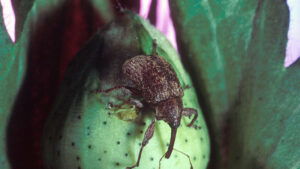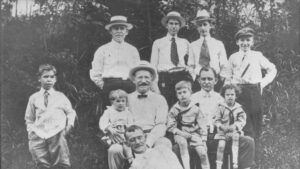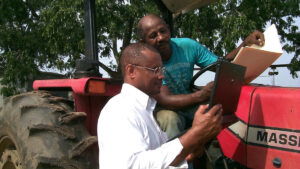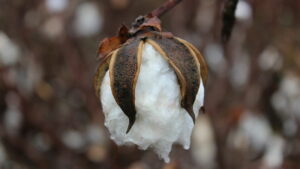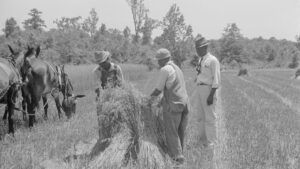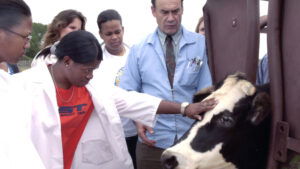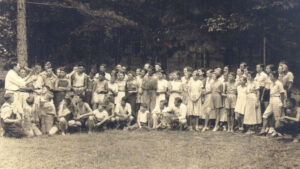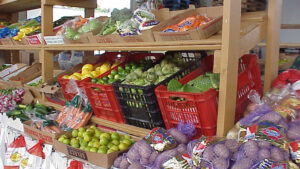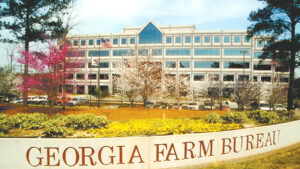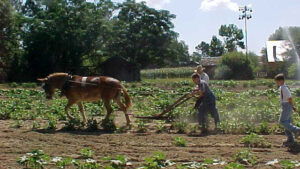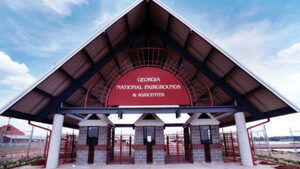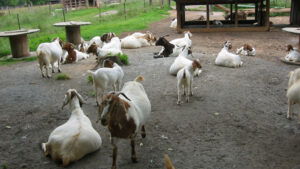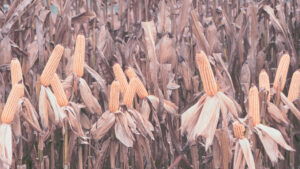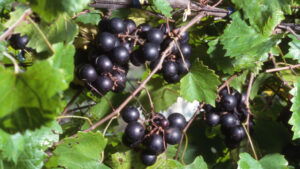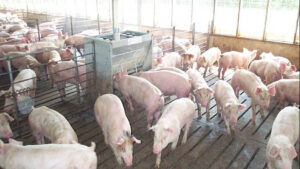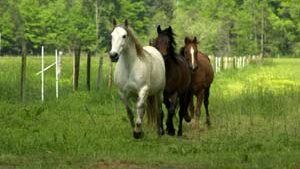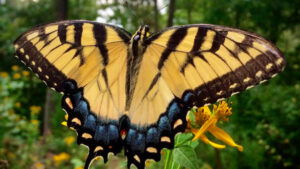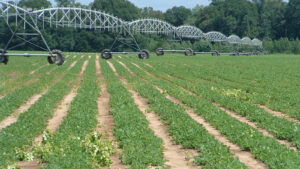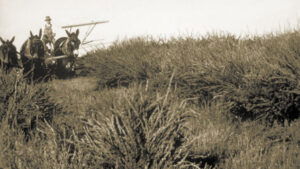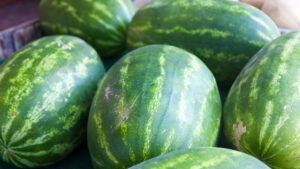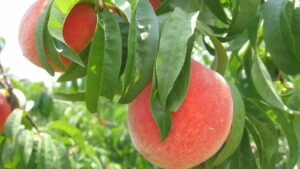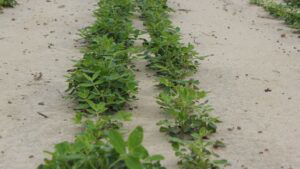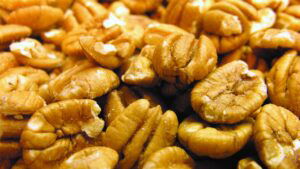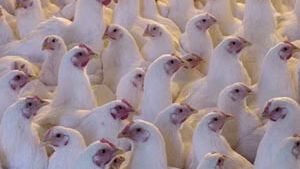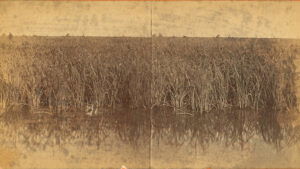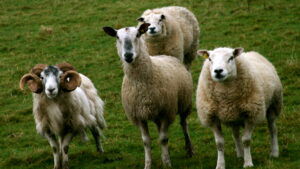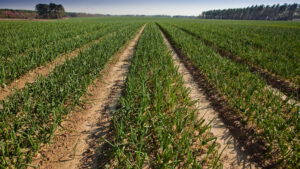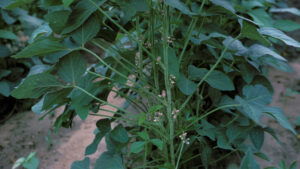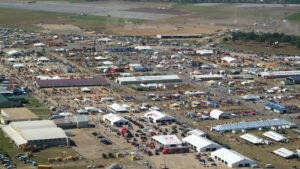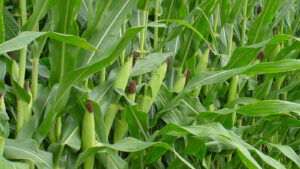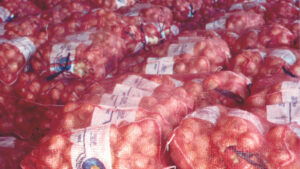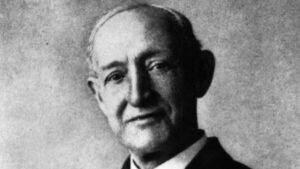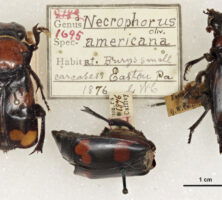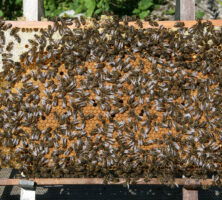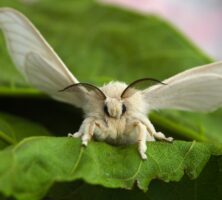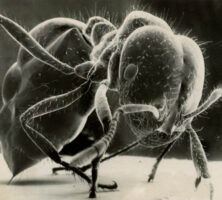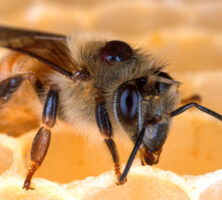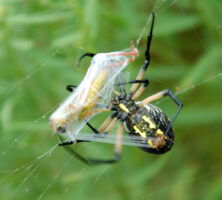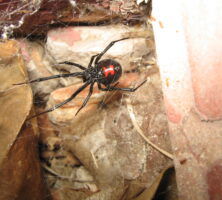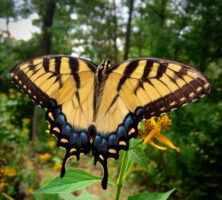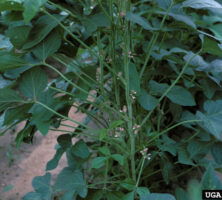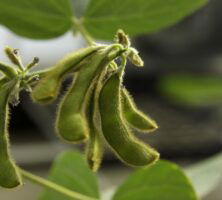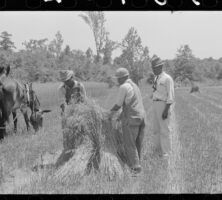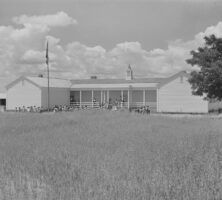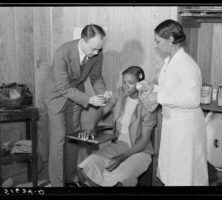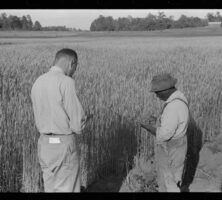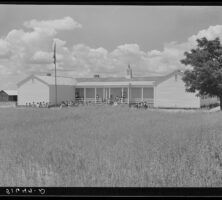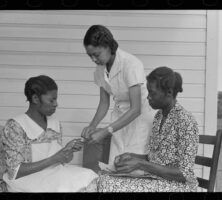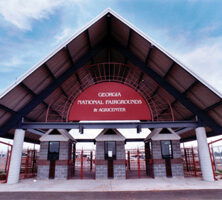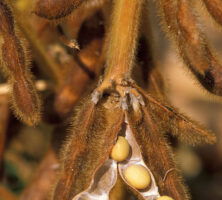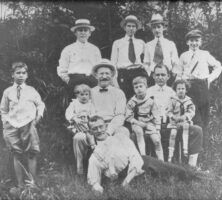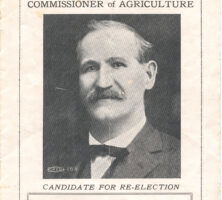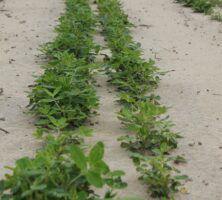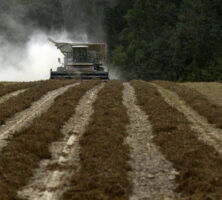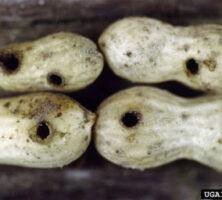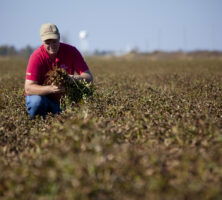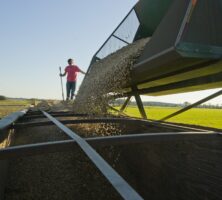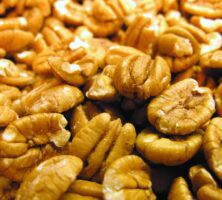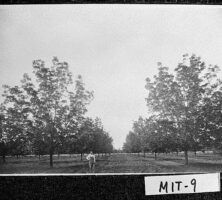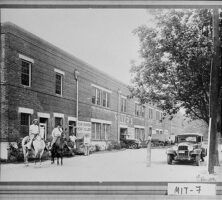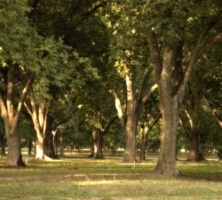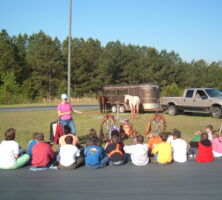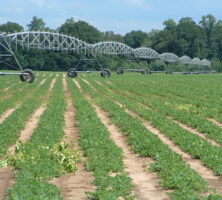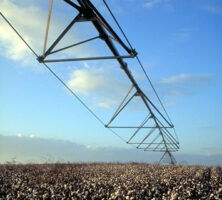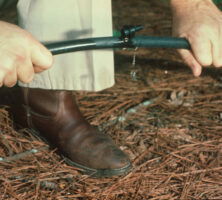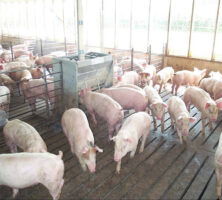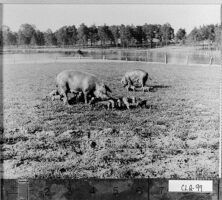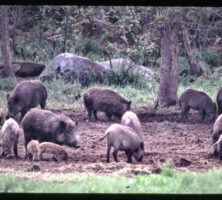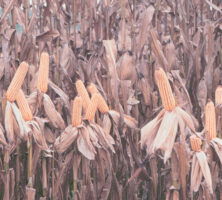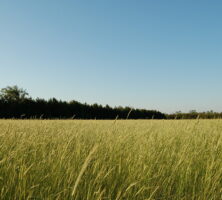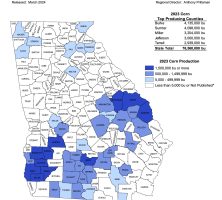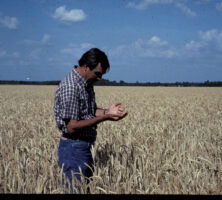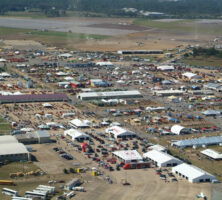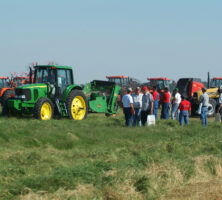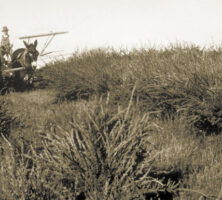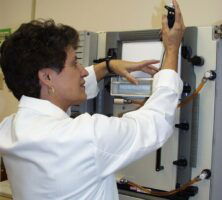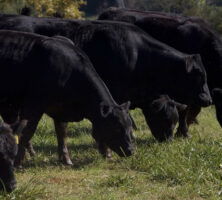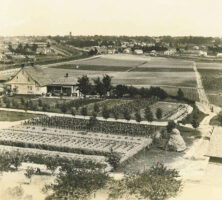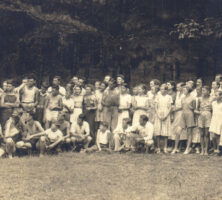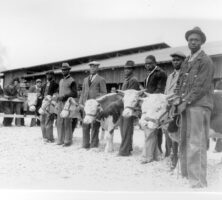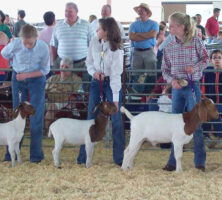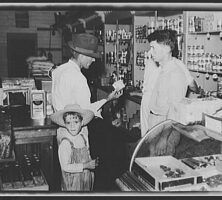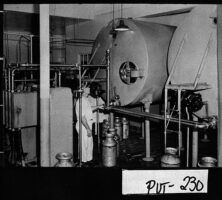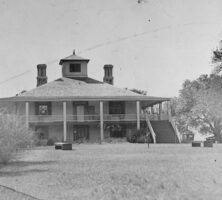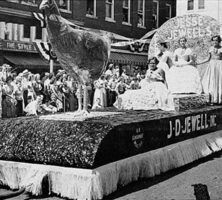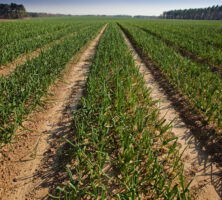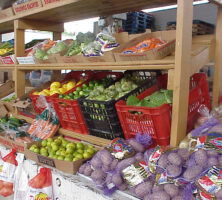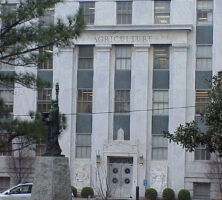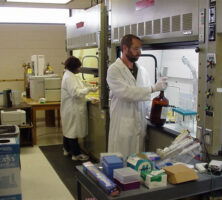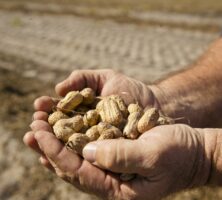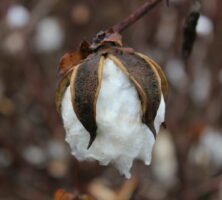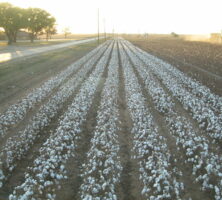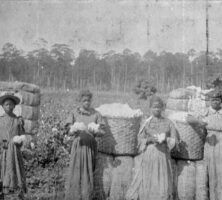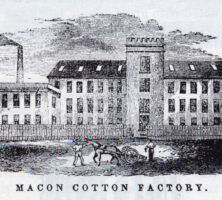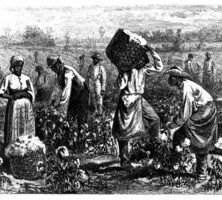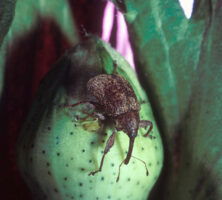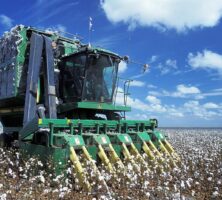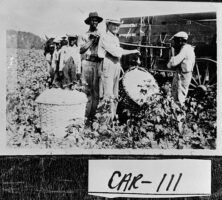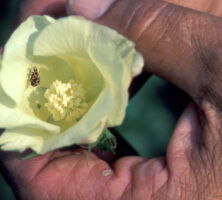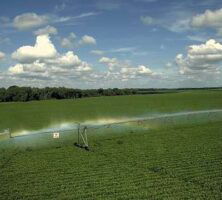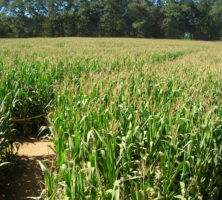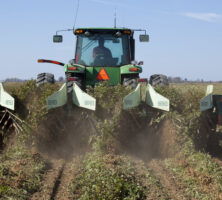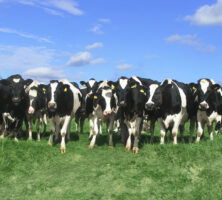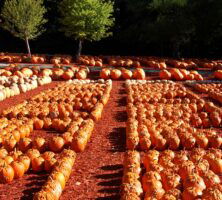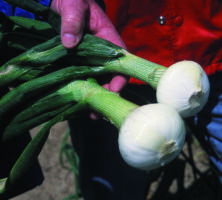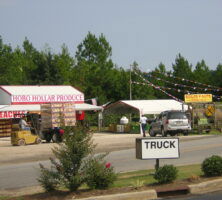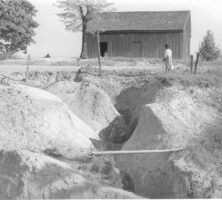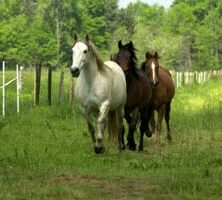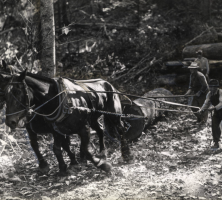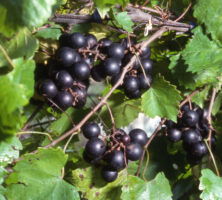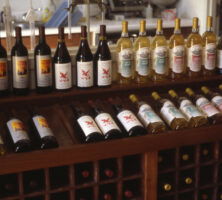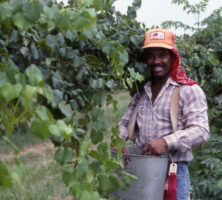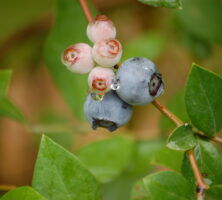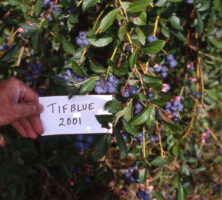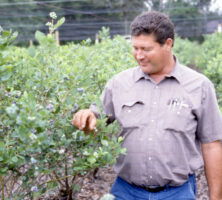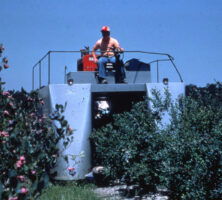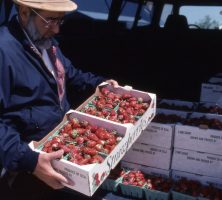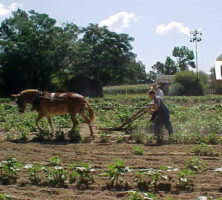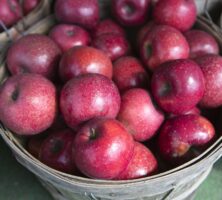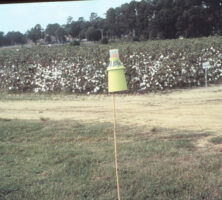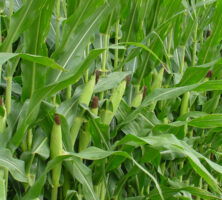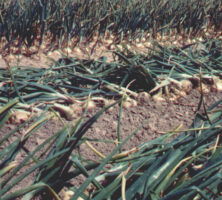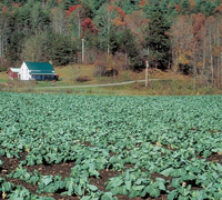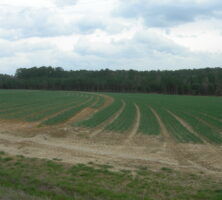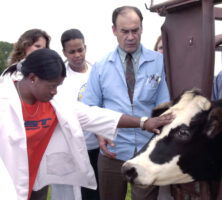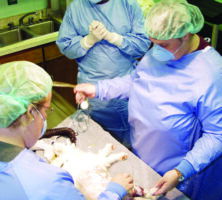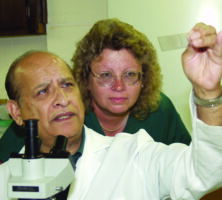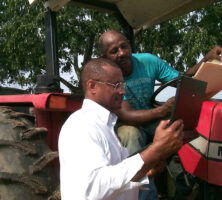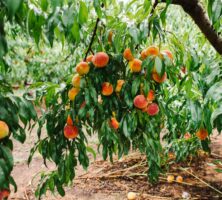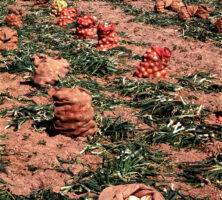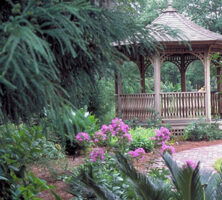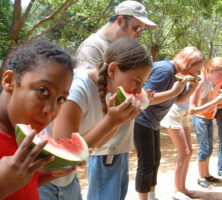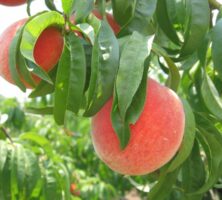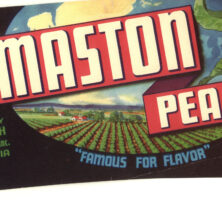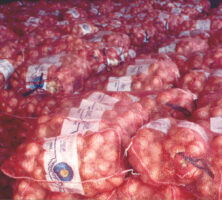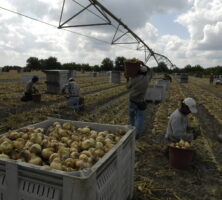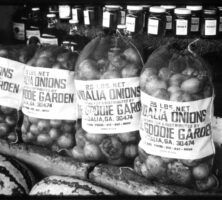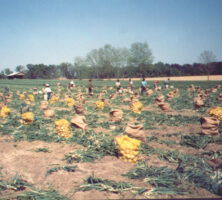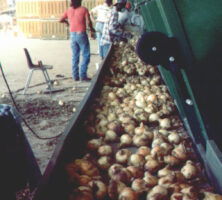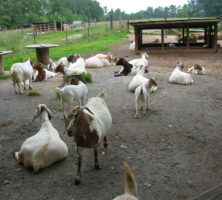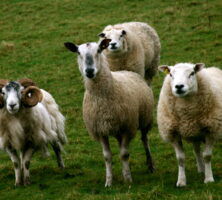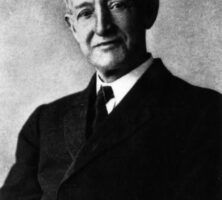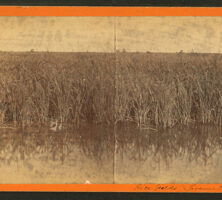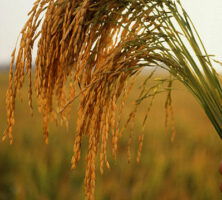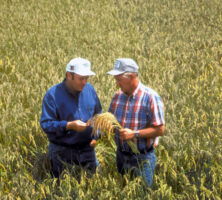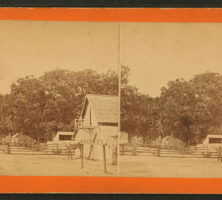The New Georgia Encyclopedia is supported by funding from A More Perfect Union, a special initiative of the National Endowment for the Humanities.
The American burying beetle, Nicrophorus americanus, is an endangered species and is no longer found in Georgia. Beetles, order Coleoptera, are the largest group of insects, and thousands of species can be found in Georgia.
Photograph by the Frost Museum
The New Georgia Encyclopedia does not hold the copyright for this media resource and can neither grant nor deny permission to republish or reproduce the image online or in print. All requests for permission to publish or reproduce the resource must be submitted to the rights holder.
European honeybees are not native to Georgia, but records show they arrived in the state by 1743. They were named the state insect in 1975. In addition to creating honey, honeybees pollinate several crops, including blueberries, apples, melons, and gourds.
Photograph by Waugsberg
The New Georgia Encyclopedia does not hold the copyright for this media resource and can neither grant nor deny permission to republish or reproduce the image online or in print. All requests for permission to publish or reproduce the resource must be submitted to the rights holder.
An adult silkmoth, Bombyx mori. This species's caterpillar, the mulberry silkworm, has produced silk textiles for millennia. Eighteenth-century Georgia colonists tried and failed to establish a silk industry in Savannah.
Photograph by Nikita
The New Georgia Encyclopedia does not hold the copyright for this media resource and can neither grant nor deny permission to republish or reproduce the image online or in print. All requests for permission to publish or reproduce the resource must be submitted to the rights holder.
Solenopsis invicta are an invasive ant species from South America. The species has interbred with native ants to create hybrid ant species that threaten soybean production. All ants are eusocial, which means they live in strict social hiearchies.
Courtesy of Atlanta Journal-Constitution.
The New Georgia Encyclopedia does not hold the copyright for this media resource and can neither grant nor deny permission to republish or reproduce the image online or in print. All requests for permission to publish or reproduce the resource must be submitted to the Atlanta Journal-Constitution.
Researchers have attributed recent declines in apiary honeybee populations to parasitic varroa mites, pictured between the bee's wings above. Varroa mites suck drone and developing brood blood, weakening individuals. An untreated varroa infestation may kill colonies.
Photograph by the U.S. Department of Agriculture
The New Georgia Encyclopedia does not hold the copyright for this media resource and can neither grant nor deny permission to republish or reproduce the image online or in print. All requests for permission to publish or reproduce the resource must be submitted to the rights holder.
The golden garden spider, Argiope aurantia, is a member of the orb-web family. Here, an individual uses its spinnerets, located on its abdomen, to trap prey. Spiders are exclusively carnivorous, though the golden garden spider is no danger to humans.
Photograph by Tom McC
The New Georgia Encyclopedia does not hold the copyright for this media resource and can neither grant nor deny permission to republish or reproduce the image online or in print. All requests for permission to publish or reproduce the resource must be submitted to the rights holder.
Widow spiders produce cobwebs and seclude themselves in dark, isolated areas. They have a painful bite, which requires medical attention, but they are rarely fatal.
Photograph by Charaj
The New Georgia Encyclopedia does not hold the copyright for this media resource and can neither grant nor deny permission to republish or reproduce the image online or in print. All requests for permission to publish or reproduce the resource must be submitted to the rights holder.
The eastern tiger swallowtail, Papilo glaucus, is the state butterfly of Georgia. It's common across the eastern United States.
Courtesy of Loy Xingwen
The New Georgia Encyclopedia does not hold the copyright for this media resource and can neither grant nor deny permission to republish or reproduce the image online or in print. All requests for permission to publish or reproduce the resource must be submitted to the rights holder.
The soybean plant, first introduced to Georgia in 1765, originated in China. The plant was brought to the Georgia colony by Samuel Bowen, who planted it after settling in Savannah. In the latter part of the nineteenth century, the U.S. Department of Agriculture encouraged the cultivation of soybeans in the state.
Photograph by Carl Dennis, Auburn University. Courtesy of IPM Images
The New Georgia Encyclopedia does not hold the copyright for this media resource and can neither grant nor deny permission to republish or reproduce the image online or in print. All requests for permission to publish or reproduce the resource must be submitted to the rights holder.
In 1924, three years after Roosevelt contracted polio, he began visiting Warm Springs in Georgia. The springs were thought to be beneficial for polio victims. Roosevelt, who became the U.S. president in 1932, is pictured in front of the Little White House in Warm Springs.
Courtesy of Georgia Info, Digital Library of Georgia.
The New Georgia Encyclopedia does not hold the copyright for this media resource and can neither grant nor deny permission to republish or reproduce the image online or in print. Requests for permission to publish or reproduce the resource may need to be submitted to the Digital Library of Georgia.
Members of a Heard County family pose in front of their cotton crop, circa 1900. Residents of the county began raising cotton in the nineteenth century, but many were forced to abandon the crop during the first decades of the twentieth century, in the wake of the boll weevil devastations and the Great Depression.
Courtesy of Georgia Archives, Vanishing Georgia, #
hrd005.
The New Georgia Encyclopedia does not hold the copyright for this media resource and can neither grant nor deny permission to republish or reproduce the image online or in print. Requests for permission to publish or reproduce the resource should be submitted to the Georgia Archives.
Soybeans were introduced to the United States by Samuel Bowen, a seaman who brought the seeds from China. At Bowen's request, Henry Yonge planted the first soybean crop on his farm in Thunderbolt, a few miles east of Savannah, in 1765.
Photograph by the United Soybean Board
The New Georgia Encyclopedia does not hold the copyright for this media resource and can neither grant nor deny permission to republish or reproduce the image online or in print. All requests for permission to publish or reproduce the resource must be submitted to the rights holder.
Alonzo Fields (far right), the farm supervisor at the Flint River Farms Resettlement Community in Macon County, directs the harvesting of oats in 1939. Flint River Farms was an experimental planned community established in 1937 for African American sharecroppers.
Courtesy of Library of Congress, Prints and Photographs Division, Farm Security Administration - Office of War Information Photograph Collection, #LC-USF33- 030402-M1 [P&P].
The New Georgia Encyclopedia does not hold the copyright for this media resource and can neither grant nor deny permission to republish or reproduce the image online or in print. All requests for permission to publish or reproduce the resource must be submitted to the rights holder.
The school building at the Flint River Farms Resettlement Community, an experimental farm established in Macon County for African American sharecroppers, included a schoolhouse, teacher's residence, and related buildings.
Courtesy of Library of Congress, Prints and Photographs Division
The New Georgia Encyclopedia does not hold the copyright for this media resource and can neither grant nor deny permission to republish or reproduce the image online or in print. All requests for permission to publish or reproduce the resource must be submitted to the rights holder.
The New Georgia Encyclopedia does not hold the copyright for this media resource and can neither grant nor deny permission to republish or reproduce the image online or in print. All requests for permission to publish or reproduce the resource must be submitted to the rights holder.
Dr. Thomas M. Adams and project nurse Lillie Mae McCormick, pictured in 1937, administer a typhoid shot in the health clinic at the Flint River Farms Resettlement Community in Macon County.
Courtesy of Library of Congress, Prints and Photographs Division, Farm Security Administration - Office of War Information Photograph Collection, #LC-USF34- 051634-D [P&P] LOT 1541.
The New Georgia Encyclopedia does not hold the copyright for this media resource and can neither grant nor deny permission to republish or reproduce the image online or in print. All requests for permission to publish or reproduce the resource must be submitted to the rights holder.
Project manager Amos Ward (left?) and Farm Security Administration borrower Simon Joiner inspect wheat in 1939 at the Flint River Farms Resettlement Community in Macon County. A variety of crops, including wheat, oats, cotton, pecans, and peaches were grown at the farms.
Courtesy of Library of Congress, Prints and Photographs Division, Farm Security Administration - Office of War Information Photograph Collection, #LC-USF33- 030398-M4 [P&P] LOT 1541.
The New Georgia Encyclopedia does not hold the copyright for this media resource and can neither grant nor deny permission to republish or reproduce the image online or in print. All requests for permission to publish or reproduce the resource must be submitted to the rights holder.
Students, pictured in 1939, gather outside the schoolhouse at the Flint River Farms Resettlement Community in Macon County. A field of oats grows in front of the school.
Courtesy of Library of Congress, Prints and Photographs Division, Farm Security Administration - Office of War Information Photograph Collection, #LC-USF34- 051647-D [P&P] LOT 1541.
The New Georgia Encyclopedia does not hold the copyright for this media resource and can neither grant nor deny permission to republish or reproduce the image online or in print. All requests for permission to publish or reproduce the resource must be submitted to the rights holder.
A classroom of first graders is pictured in 1939 at the Flint River Farms Resettlement Community in Macon County. The school opened to elementary-age children in 1938, and by 1946 it offered classes in all twelve grades.
Courtesy of Library of Congress, Prints and Photographs Division, Farm Security Administration - Office of War Information Photograph Collection, #LC-USF34- 051617-D [P&P] LOT 1541.
The New Georgia Encyclopedia does not hold the copyright for this media resource and can neither grant nor deny permission to republish or reproduce the image online or in print. All requests for permission to publish or reproduce the resource must be submitted to the rights holder.
Evelyn M. Driver (center) instructs students in home economics and management in 1939 at the Flint River Farms Resettlement Community in Macon County.
Courtesy of Library of Congress, Prints and Photographs Division, Farm Security Administration - Office of War Information Photograph Collection, #LC-USF33- 030379-M3 [P&P] LOT 1541.
The New Georgia Encyclopedia does not hold the copyright for this media resource and can neither grant nor deny permission to republish or reproduce the image online or in print. All requests for permission to publish or reproduce the resource must be submitted to the rights holder.
The New Georgia Encyclopedia does not hold the copyright for this media resource and can neither grant nor deny permission to republish or reproduce the image online or in print. All requests for permission to publish or reproduce the resource must be submitted to the rights holder.
The New Georgia Encyclopedia does not hold the copyright for this media resource and can neither grant nor deny permission to republish or reproduce the image online or in print. All requests for permission to publish or reproduce the resource must be submitted to the rights holder.
D. W. Brooks, a national agricultural leader for much of the twentieth century, was a native of Franklin County. In 1933, along with five farmers, he founded the Georgia Cotton Cooperative Association in Carroll County. The cooperative, later known as the Cotton Producers Association, changed its name to Gold Kist in 1974.
Courtesy of Richard B. Russell Library for Political Research and Studies, University of Georgia Libraries, D. W. Brooks Papers.
The New Georgia Encyclopedia does not hold the copyright for this media resource and can neither grant nor deny permission to republish or reproduce the image online or in print. Requests for permission to publish or reproduce the resource may need to be submitted to the Richard B. Russell Library for Political Research and Studies at the University of Georgia.
D. W. Brooks speaks before a meeting of the Georgia Cotton Cooperative Association, which he cofounded in Carroll County in 1933. The association fostered cooperation among farmers to help them overcome numerous economic difficulties. Initially focused on cotton, the cooperative expanded into insurance, fertilizer, seed, and other farm supplies during the 1940s.
Courtesy of Richard B. Russell Library for Political Research and Studies, University of Georgia Libraries, D. W. Brooks Papers.
The New Georgia Encyclopedia does not hold the copyright for this media resource and can neither grant nor deny permission to republish or reproduce the image online or in print. Requests for permission to publish or reproduce the resource may need to be submitted to the Richard B. Russell Library for Political Research and Studies at the University of Georgia.
D. W. Brooks (left), a Georgia native, sits with U.S. president Jimmy Carter. Carter was one of seven presidents to be advised by Brooks on agricultural policy.
Courtesy of Richard B. Russell Library for Political Research and Studies, University of Georgia Libraries, D. W. Brooks Papers.
The New Georgia Encyclopedia does not hold the copyright for this media resource and can neither grant nor deny permission to republish or reproduce the image online or in print. Requests for permission to publish or reproduce the resource may need to be submitted to the Richard B. Russell Library for Political Research and Studies at the University of Georgia.
The main entrance of the Georgia National Fairgrounds and Agricenter, located in Perry, is pictured in 1990. The facility hosts the Georgia National Fair each October, in addition to a variety of sporting and agricultural events throughout the year.
Courtesy of Atlanta Journal-Constitution.
The New Georgia Encyclopedia does not hold the copyright for this media resource and can neither grant nor deny permission to republish or reproduce the image online or in print. All requests for permission to publish or reproduce the resource must be submitted to the Atlanta Journal-Constitution.
The New Georgia Encyclopedia does not hold the copyright for this media resource and can neither grant nor deny permission to republish or reproduce the image online or in print. All requests for permission to publish or reproduce the resource must be submitted to the rights holder.
Mature soybeans, still in their pods, are ready for harvest. Most of the approximately 8.37 million bushels of soybeans produced annually in Georgia are used in the manufacture of cooking oil and animal feed.
Photograph by Scott Bauer, USDA Agricultural Research Service. Courtesy of IPM Images
The New Georgia Encyclopedia does not hold the copyright for this media resource and can neither grant nor deny permission to republish or reproduce the image online or in print. All requests for permission to publish or reproduce the resource must be submitted to the rights holder.
The New Georgia Encyclopedia does not hold the copyright for this media resource and can neither grant nor deny permission to republish or reproduce the image online or in print. All requests for permission to publish or reproduce the resource must be submitted to the rights holder.
J. J. Brown (seated left), Georgia's eighth commissioner of agriculture, poses at John Harris's fish camp on the Chattahoochee River with Governor Hugh M. Dorsey (seated right), circa 1918.
Courtesy of Watson-Brown Foundation, Inc.
The New Georgia Encyclopedia does not hold the copyright for this media resource and can neither grant nor deny permission to republish or reproduce the image online or in print. All requests for permission to publish or reproduce the resource must be submitted to the rights holder.
The New Georgia Encyclopedia does not hold the copyright for this media resource and can neither grant nor deny permission to republish or reproduce the image online or in print. All requests for permission to publish or reproduce the resource must be submitted to the rights holder.
J. J. Brown won five consecutive terms as Georgia's commissioner of agriculture, serving from 1917 to 1927. During his tenure, Brown created a state Bureau of Markets and established the Market Bulletin, a free weekly periodical for Georgia farmers still in circulation today as the Farmers and Consumers Market Bulletin.
Courtesy of Watson-Brown Foundation, Inc.
The New Georgia Encyclopedia does not hold the copyright for this media resource and can neither grant nor deny permission to republish or reproduce the image online or in print. All requests for permission to publish or reproduce the resource must be submitted to the rights holder.
The long growing season and sandy soils of Georgia are ideal for producing peanuts (Arachis hypogaea L.), a legume native to South America. Georgia produces nearly half of the country's peanuts.
Photograph by the Georgia Peanut Commission
The New Georgia Encyclopedia does not hold the copyright for this media resource and can neither grant nor deny permission to republish or reproduce the image online or in print. All requests for permission to publish or reproduce the resource must be submitted to the rights holder.
A peanut crop in Effingham County is harvested in 2005.
Photo by Stephen Morton, UGA College of Agriculture
The New Georgia Encyclopedia does not hold the copyright for this media resource and can neither grant nor deny permission to republish or reproduce the image online or in print. All requests for permission to publish or reproduce the resource must be submitted to the rights holder.
A load of peanuts is delivered to market in Seminole County by Irene Dozier (on ground), Millie Trulock (second from left on cab), and others in November 1941. The cultivation of peanuts, used to produce oil, was encouraged in Georgia during World War II.
Courtesy of Georgia Archives, Vanishing Georgia, #
sem104-82.
The New Georgia Encyclopedia does not hold the copyright for this media resource and can neither grant nor deny permission to republish or reproduce the image online or in print. Requests for permission to publish or reproduce the resource should be submitted to the Georgia Archives.
Peanut pods decay as a result of holes bored by wireworms, also known as click beetles, which feed on the underground portions of many Georgia crops.
Photograph by Steve L. Brown, University of Georgia. Courtesy of Forestry Images
The New Georgia Encyclopedia does not hold the copyright for this media resource and can neither grant nor deny permission to republish or reproduce the image online or in print. All requests for permission to publish or reproduce the resource must be submitted to the rights holder.
A peanut farmer investigates his crop. Representatives of all segments of the peanut industry, from grower to manufacturer, are active in Georgia, as are a variety of affiliated industries.
Photograph by uacescomm
The New Georgia Encyclopedia does not hold the copyright for this media resource and can neither grant nor deny permission to republish or reproduce the image online or in print. All requests for permission to publish or reproduce the resource must be submitted to the rights holder.
Peanuts, which are planted in April or May, are harvested in September.
Courtesy of Explore Georgia, Photograph by Ralph Daniel.
The New Georgia Encyclopedia does not hold the copyright for this media resource and can neither grant nor deny permission to republish or reproduce the image online or in print. Requests for permission to publish or reproduce the resource may need to be submitted to Explore Georgia.
During an oral history interview conducted in July 2014, Frank McGill recalls his career in the University of Georgia's Extension Service, becoming an expert on peanut production, and the effect of the peanut economy on small towns in Georgia.Interview with Frank McGill and Lois Boyd, First Person Project, FPP 53.
The New Georgia Encyclopedia does not hold the copyright for this media resource and can neither grant nor deny permission to republish or reproduce the image online or in print. Requests for permission to publish or reproduce the resource may need to be submitted to the Richard B. Russell Library for Political Research and Studies at the University of Georgia.
Pecan nuts are the fruit of pecan trees (Carya illinoensis), a species of hickory in the walnut family. First grown commercially in Georgia during the late 1880s, pecans became one of the state's most important commodities by the early 1900s. As of 2014 Georgia produced the most pecans in the country.
Photograph by Judy Baxter
The New Georgia Encyclopedia does not hold the copyright for this media resource and can neither grant nor deny permission to republish or reproduce the image online or in print. All requests for permission to publish or reproduce the resource must be submitted to the rights holder.
A farmer stands in a Mitchell County pecan grove in the early twentieth century. The grove was one of the first to be planted in the county. Pecans, along with cotton, peanuts, and soybeans, continue to be an important agricultural product in Mitchell County.
Courtesy of Georgia Archives, Vanishing Georgia, #
mit009.
The New Georgia Encyclopedia does not hold the copyright for this media resource and can neither grant nor deny permission to republish or reproduce the image online or in print. Requests for permission to publish or reproduce the resource should be submitted to the Georgia Archives.
Miller's Pecan Company, shown in 1932, was said to have been one of the largest pecan companies in the world during its time. Located in Baconton, in Mitchell County, the company cracked and shelled pecans, grading them by hand, and sold pecan tree saplings to growers.
Courtesy of Georgia Archives, Vanishing Georgia, #
mit007.
The New Georgia Encyclopedia does not hold the copyright for this media resource and can neither grant nor deny permission to republish or reproduce the image online or in print. Requests for permission to publish or reproduce the resource should be submitted to the Georgia Archives.
Since the 1950s Georgia has been the top producer of pecans in the nation.
Photograph by Mark Strozier
The New Georgia Encyclopedia does not hold the copyright for this media resource and can neither grant nor deny permission to republish or reproduce the image online or in print. All requests for permission to publish or reproduce the resource must be submitted to the rights holder.
The headquarters of the Georgia Farm Bureau, a state-level affiliate of the American Farm Bureau, are located in Macon. The bureau developed in response to the Smith-Lever Act of 1914 and continues to promote the interests of farmers in the twenty-first century.
Courtesy of Georgia Farm Bureau
The New Georgia Encyclopedia does not hold the copyright for this media resource and can neither grant nor deny permission to republish or reproduce the image online or in print. All requests for permission to publish or reproduce the resource must be submitted to the rights holder.
Farmers arrive at a meeting of the Georgia Farm Bureau held at the Auburn Consolidated School in Barrow County, circa 1935. The state bureau is affiliated with the American Farm Bureau, which was an active participant in Franklin D. Roosevelt's New Deal programs during the 1930s.
Courtesy of Georgia Archives, Vanishing Georgia, #
brw060.
The New Georgia Encyclopedia does not hold the copyright for this media resource and can neither grant nor deny permission to republish or reproduce the image online or in print. Requests for permission to publish or reproduce the resource should be submitted to the Georgia Archives.
Shannon Moore, a member of the Georgia Farm Bureau in Jasper County, conducts Farm Day activities for fifth-grade students. Farm Day, an event sponsored by the bureau in locations around the state, is a forum for teaching children about agriculture.
Courtesy of Georgia Farm Bureau
The New Georgia Encyclopedia does not hold the copyright for this media resource and can neither grant nor deny permission to republish or reproduce the image online or in print. All requests for permission to publish or reproduce the resource must be submitted to the rights holder.
A peanut field in Stewart County is watered by a center-pivot irrigation system. In Georgia approximately 10,000 center-pivot systems, primarily found in the Dougherty Plain of the Flint River, are used to irrigate a variety of crops.
Courtesy of Matthew M. Moye
The New Georgia Encyclopedia does not hold the copyright for this media resource and can neither grant nor deny permission to republish or reproduce the image online or in print. All requests for permission to publish or reproduce the resource must be submitted to the rights holder.
A center-pivot irrigation system waters a cotton field. Central-pivot and drip irrigation are the primary systems used on more than 1.5 million acres of farmland across the state to supplement the annual forty to fifty inches of rainfall in Georgia.
Courtesy of Georgia Department of Economic Development.
The New Georgia Encyclopedia does not hold the copyright for this media resource and can neither grant nor deny permission to republish or reproduce the image online or in print. Requests for permission to publish or reproduce the resource may need to be submitted to the Georgia Department of Economic Development.
Efficient irrigation is one of the seven steps involved in Xeriscape gardening, a method of gardening used primarily in urban areas to conserve water while maintaining lawns and plants. Drip irrigation and hand watering help target irrigation to plants that need it.
Photograph by Gary L. Wade
The New Georgia Encyclopedia does not hold the copyright for this media resource and can neither grant nor deny permission to republish or reproduce the image online or in print. All requests for permission to publish or reproduce the resource must be submitted to the rights holder.
Hog production in Georgia was responsible for 8 percent of the state's livestock and aquaculture income in 2004. The number of hogs raised in Georgia declined during the late twentieth century, dropping from a high of 2.4 million head in 1979 to 345,000 in 2002.
Courtesy of Ken Stalder, Department of Animal Science, Iowa State University
The New Georgia Encyclopedia does not hold the copyright for this media resource and can neither grant nor deny permission to republish or reproduce the image online or in print. All requests for permission to publish or reproduce the resource must be submitted to the rights holder.
Hogs tend to their young on a Colquitt County farm during the 1970s. First introduced to Georgia in the 1500s, hogs were raised by colonial settlers and became a primary food source during the nineteenth century. Hogs continued to be a major crop in the state until the 1980s.
Courtesy of Georgia Archives, Vanishing Georgia, #
clq099.
The New Georgia Encyclopedia does not hold the copyright for this media resource and can neither grant nor deny permission to republish or reproduce the image online or in print. Requests for permission to publish or reproduce the resource should be submitted to the Georgia Archives.
Although hogs were typically raised outdoors until the 1980s, today they are usually housed in environmentally controlled facilities. Such facilities allow farmers to increase the production of hogs while reducing the incidence of disease among the animals.
Courtesy of Ken Stalder, Department of Animal Science, Iowa State University
The New Georgia Encyclopedia does not hold the copyright for this media resource and can neither grant nor deny permission to republish or reproduce the image online or in print. All requests for permission to publish or reproduce the resource must be submitted to the rights holder.
Although feral, or wild, hogs are found througout the state, their population is concentrated in coastal areas. Considered a nuisance, feral hogs are destructive to both human crops and structures and are also known to carry diseases communicable to farm and domestic animals.
Courtesy of Wildlife Resources Division, Georgia Department of Natural Resources
The New Georgia Encyclopedia does not hold the copyright for this media resource and can neither grant nor deny permission to republish or reproduce the image online or in print. All requests for permission to publish or reproduce the resource must be submitted to the rights holder.
The New Georgia Encyclopedia does not hold the copyright for this media resource and can neither grant nor deny permission to republish or reproduce the image online or in print. All requests for permission to publish or reproduce the resource must be submitted to the rights holder.
The New Georgia Encyclopedia does not hold the copyright for this media resource and can neither grant nor deny permission to republish or reproduce the image online or in print. All requests for permission to publish or reproduce the resource must be submitted to the rights holder.
Several varieties of corn, including flour, flint, dent, pop, and sweet, are grown in Georgia during the summer months. Although the pop and sweet varieties are produced for human consumption, most of the corn raised in Georgia is used for animal feed.
Courtesy of Dewey Lee
The New Georgia Encyclopedia does not hold the copyright for this media resource and can neither grant nor deny permission to republish or reproduce the image online or in print. All requests for permission to publish or reproduce the resource must be submitted to the rights holder.
Most of the corn and wheat production in Georgia occurs in the southern counties. These areas are generally characterized by gently sloping or flat lands of well-drained soils, mostly of the clay loam to sandy loam soil types.
Image from Dizzy Girl
The New Georgia Encyclopedia does not hold the copyright for this media resource and can neither grant nor deny permission to republish or reproduce the image online or in print. All requests for permission to publish or reproduce the resource must be submitted to the rights holder.
Georgia's top corn-producing county in 2023 was Burke County, which produced more than 4.1 million bushels. Corn, the state's main summer crop, is grown primarily in south Georgia and often requires irrigation.
Courtesy of Georgia Agricultural Statistics Service
The New Georgia Encyclopedia does not hold the copyright for this media resource and can neither grant nor deny permission to republish or reproduce the image online or in print. All requests for permission to publish or reproduce the resource must be submitted to the rights holder.
A Georgia farmer examines his wheat crop, which is grown during the winter months. Soft red winter wheat, raised primarily for flour to be used in the baking industry, is the main variety produced in the state, although scientists are also experimenting with soft white wheat.
Courtesy of Dewey Lee
The New Georgia Encyclopedia does not hold the copyright for this media resource and can neither grant nor deny permission to republish or reproduce the image online or in print. All requests for permission to publish or reproduce the resource must be submitted to the rights holder.
The Sunbelt Agricultural Exposition, held in Moultrie each year during the third week of October, features crop, livestock, and equipment demonstrations. The expo, which brings in an estimated $30 million to the area each year, attracted 200,000 visitors in 2005.
Photograph by Bob Parker. Courtesy of Sunbelt Agricultural Exposition
The New Georgia Encyclopedia does not hold the copyright for this media resource and can neither grant nor deny permission to republish or reproduce the image online or in print. All requests for permission to publish or reproduce the resource must be submitted to the rights holder.
New farm equipment is demonstrated in a field during the 2005 Sunbelt Agricultural Exposition. Potential buyers have the opportunity to test drive all-terrain vehicles, tractors, and trucks during the weeklong annual event in Moultrie.
Photograph by Branch Carter. Courtesy of Sunbelt Agricultural Exposition
The New Georgia Encyclopedia does not hold the copyright for this media resource and can neither grant nor deny permission to republish or reproduce the image online or in print. All requests for permission to publish or reproduce the resource must be submitted to the rights holder.
The New Georgia Encyclopedia does not hold the copyright for this media resource and can neither grant nor deny permission to republish or reproduce the image online or in print. All requests for permission to publish or reproduce the resource must be submitted to the rights holder.
Located in Griffin, the Georgia Experiment Station is one of three agricultural experiment stations in the state operated by the University of Georgia College of Agricultural and Environmental Sciences.
Courtesy of Jay Bauer, University of Georgia College of Agricultural and Environmental Sciences
The New Georgia Encyclopedia does not hold the copyright for this media resource and can neither grant nor deny permission to republish or reproduce the image online or in print. All requests for permission to publish or reproduce the resource must be submitted to the rights holder.
A researcher at the Georgia Experiment Station in Griffin plows a field behind a three-mule team in 1900. Around this time, scientists at the station developed the deep furrow method of planting winter oats, a technique that saved millions of dollars for farmers in the South.
Courtesy of University of Georgia College of Agricultural and Environmental Sciences
The New Georgia Encyclopedia does not hold the copyright for this media resource and can neither grant nor deny permission to republish or reproduce the image online or in print. All requests for permission to publish or reproduce the resource must be submitted to the rights holder.
Tracie Jenkins, a geneticist at the Georgia Experiment Station in Griffin, studies the genetic makeup of termites, a major urban pest in the South. Her work has documented four different species of termites in Georgia.
Courtesy of University of Georgia College of Agricultural and Environmental Sciences
The New Georgia Encyclopedia does not hold the copyright for this media resource and can neither grant nor deny permission to republish or reproduce the image online or in print. All requests for permission to publish or reproduce the resource must be submitted to the rights holder.
The first formulated feed diets for dairy and beef cattle in Georgia were discovered by scientists at the Georgia Experiment Station in Griffin in the early twentieth century.
Image from UGA CAES/Extension
The New Georgia Encyclopedia does not hold the copyright for this media resource and can neither grant nor deny permission to republish or reproduce the image online or in print. All requests for permission to publish or reproduce the resource must be submitted to the rights holder.
Gil Landry, a turfgrass specialist at the Georgia Experiment Station in Griffin, researches the use of sod to control soil erosion along the state's roadways.
Courtesy of University of Georgia College of Agricultural and Environmental Sciences
The New Georgia Encyclopedia does not hold the copyright for this media resource and can neither grant nor deny permission to republish or reproduce the image online or in print. All requests for permission to publish or reproduce the resource must be submitted to the rights holder.
The Georgia Experiment Station in Griffin, pictured around 1907, was established in 1888 to perform agricultural research in such areas as fertilizers, soil erosion, and crop varieties. These studies led to the modernization of agricultural techniques in the South.
Image from UGA CAES/Extension
The New Georgia Encyclopedia does not hold the copyright for this media resource and can neither grant nor deny permission to republish or reproduce the image online or in print. All requests for permission to publish or reproduce the resource must be submitted to the rights holder.
The New Georgia Encyclopedia does not hold the copyright for this media resource and can neither grant nor deny permission to republish or reproduce the image online or in print. All requests for permission to publish or reproduce the resource must be submitted to the rights holder.
Members of 4-H clubs gather in 1935 at Forest Camp in Cobb County. The 4-H organization first became active in Georgia in 1904, and in 1914 it was designated the youth program of the University of Georgia Cooperative Extension Service.
Courtesy of Georgia 4-H
The New Georgia Encyclopedia does not hold the copyright for this media resource and can neither grant nor deny permission to republish or reproduce the image online or in print. All requests for permission to publish or reproduce the resource must be submitted to the rights holder.
The New Georgia Encyclopedia does not hold the copyright for this media resource and can neither grant nor deny permission to republish or reproduce the image online or in print. All requests for permission to publish or reproduce the resource must be submitted to the rights holder.
4-H members exhibit at the Augusta Fat Stock Show in 1938. Before the integration of Georgia 4-H clubs in 1967, the Black division of 4-H was headquartered at Savannah State College, and separate events were held for its members in Dublin.
Courtesy of Georgia 4-H
The New Georgia Encyclopedia does not hold the copyright for this media resource and can neither grant nor deny permission to republish or reproduce the image online or in print. All requests for permission to publish or reproduce the resource must be submitted to the rights holder.
Georgia 4-H centers are located in Eatonton, Tybee Island, Jekyll Island, Wahsega, and Fortson. The symbol for the organization is a four-leaf clover depicting the four H's, which stand for Head, Heart, Hands, and Health.
Courtesy of Georgia 4-H
The New Georgia Encyclopedia does not hold the copyright for this media resource and can neither grant nor deny permission to republish or reproduce the image online or in print. All requests for permission to publish or reproduce the resource must be submitted to the rights holder.
Two 4-H members perform an egg candling and grading demonstration in Polk County in 1932.
Courtesy of Georgia 4-H
The New Georgia Encyclopedia does not hold the copyright for this media resource and can neither grant nor deny permission to republish or reproduce the image online or in print. All requests for permission to publish or reproduce the resource must be submitted to the rights holder.
Five 4-H members exhibit goats during a show.
Courtesy of Georgia 4-H, Photograph by Judy Ashley..
The New Georgia Encyclopedia does not hold the copyright for this media resource and can neither grant nor deny permission to republish or reproduce the image online or in print. All requests for permission to publish or reproduce the resource must be submitted to the rights holder.
Three girls in 4-H watch a hygiene demonstration, circa 1968. 4-H members frequently learn and compete through the use of demonstrations and presentations.
Courtesy of Georgia 4-H
The New Georgia Encyclopedia does not hold the copyright for this media resource and can neither grant nor deny permission to republish or reproduce the image online or in print. All requests for permission to publish or reproduce the resource must be submitted to the rights holder.
Farmers gather in 1949 for the opening of the Farmers Mutual Exchange, likely a cooperative for cotton producers, in Winder.
Courtesy of Georgia Archives, Vanishing Georgia, #
brw171.
The New Georgia Encyclopedia does not hold the copyright for this media resource and can neither grant nor deny permission to republish or reproduce the image online or in print. Requests for permission to publish or reproduce the resource should be submitted to the Georgia Archives.
In 1906 Charles Barrett, a native of Pike County, began his twenty-two-year presidency of the Farmer's Union, a national organization that encouraged farmers to improve productivity and income by creating cooperatives.
Courtesy of Hargrett Rare Book and Manuscript Library, University of Georgia Libraries, Georgia Photo File.
The New Georgia Encyclopedia does not hold the copyright for this media resource and can neither grant nor deny permission to republish or reproduce the image online or in print. Requests for permission to publish or reproduce the resource should be submitted to the Hargrett Manuscript and Rare Book Library at the University of Georgia.
A farmer shops at the Irwinville Farms cooperative store (Irwin County) in 1938. Promoted by such national organizations as the National Grange and the Farmer's Union, cooperatives formed among farmers to acquire equipment, seed, and other supplies, as well as to organize the processing and marketing of their crops.
Courtesy of Library of Congress, Prints and Photographs Division
The New Georgia Encyclopedia does not hold the copyright for this media resource and can neither grant nor deny permission to republish or reproduce the image online or in print. All requests for permission to publish or reproduce the resource must be submitted to the rights holder.
A worker, pictured in 1952 at the Eatonton Cooperative Creamery in Putnam County, processes milk.
Courtesy of Georgia Archives, Vanishing Georgia, #put230.
The New Georgia Encyclopedia does not hold the copyright for this media resource and can neither grant nor deny permission to republish or reproduce the image online or in print. Requests for permission to publish or reproduce the resource should be submitted to the Georgia Archives.
Fruitland Manor, the home of horticulturist Louis Berckmans, stands on the grounds of Berckmans Nursery. Berckmans and his son Prosper founded the nursery in 1858 and introduced a range of new fruit varieties and shrubs to the Southeast.
Courtesy of Georgia Archives, Vanishing Georgia, # ric035.
The New Georgia Encyclopedia does not hold the copyright for this media resource and can neither grant nor deny permission to republish or reproduce the image online or in print. Requests for permission to publish or reproduce the resource should be submitted to the Georgia Archives.
The Augusta National Golf Club, home of the Masters Tournament, was established by golfer Bobby Jones on the former grounds of Berckmans Nursery in 1931. The landscaping of the golf course includes many of the ornamental plants propagated between 1858 and 1918 by Louis and Prosper Berckmans.
Image from Brett Chisum
The New Georgia Encyclopedia does not hold the copyright for this media resource and can neither grant nor deny permission to republish or reproduce the image online or in print. All requests for permission to publish or reproduce the resource must be submitted to the rights holder.
In a north Georgia chicken house, thousands of hens lay hatching eggs for a company that exports the fertilized eggs to hatcheries around the world.
Courtesy of Carl Weinberg
The New Georgia Encyclopedia does not hold the copyright for this media resource and can neither grant nor deny permission to republish or reproduce the image online or in print. All requests for permission to publish or reproduce the resource must be submitted to the rights holder.
The J. D. Jewell, Incorporated, float in Gainesville's Poultry Festival Parade is pictured circa 1950. Georgia is one of the top producers of broilers in the nation.
Courtesy of Georgia Archives, Vanishing Georgia, #
hal388.
The New Georgia Encyclopedia does not hold the copyright for this media resource and can neither grant nor deny permission to republish or reproduce the image online or in print. Requests for permission to publish or reproduce the resource should be submitted to the Georgia Archives.
A Georgia poultry processing plant in 1961. The state's poultry industry produces an average of 24.6 million pounds of chicken and 14 million eggs daily.
Courtesy of Special Collections & Archives, Georgia State University Library, Tracy O'Neal Photographic Collection, 1923-1975.
The New Georgia Encyclopedia does not hold the copyright for this media resource and can neither grant nor deny permission to republish or reproduce the image online or in print. Requests for permission to publish or reproduce the resource should be submitted to Special Collections and Archives at Georgia State University.
Abit Massey served as president of the Georgia Poultry Federation for forty-eight years and was named president emeritus in 2009. In an oral history interview conducted on September 19, 2011, Massey discusses the birth of the poultry industry in Georgia and its modern economic impact.
Courtesy of Richard B. Russell Library for Political Research and Studies, University of Georgia Libraries, Reflections on Georgia Politics Oral History Collection, #ROGP 131.
The New Georgia Encyclopedia does not hold the copyright for this media resource and can neither grant nor deny permission to republish or reproduce the image online or in print. Requests for permission to publish or reproduce the resource may need to be submitted to the Richard B. Russell Library for Political Research and Studies at the University of Georgia.
Vidalia onions grow in Toombs County, one of the counties served by an extension office of the Small Farmer Outreach Training and Technical Assistance Project of Fort Valley State University.
Courtesy of Explore Georgia, Photograph by Ralph Daniel.
The New Georgia Encyclopedia does not hold the copyright for this media resource and can neither grant nor deny permission to republish or reproduce the image online or in print. Requests for permission to publish or reproduce the resource may need to be submitted to Explore Georgia.
Major Raphael Moses, as chief supply officer for General James Longstreet, carried out the final order of the Confederate government. He is also credited with being the first to ship and sell peaches outside of the South.
The New Georgia Encyclopedia does not hold the copyright for this media resource and can neither grant nor deny permission to republish or reproduce the image online or in print. All requests for permission to publish or reproduce the resource must be submitted to the rights holder.
One of the largest markets in the world, the Atlanta State Farmers Market covers 150 acres and offers consumers the opportunity to buy directly from farm producers. The market opened in Forest Park in 1959 and features a nursery with indoor and outdoor plants, restaurant, gift shop, and welcome center.
Courtesy of Georgia Department of Agriculture
The New Georgia Encyclopedia does not hold the copyright for this media resource and can neither grant nor deny permission to republish or reproduce the image online or in print. All requests for permission to publish or reproduce the resource must be submitted to the rights holder.
Front facade of the Georgia Department of Agriculture building on Martin Luther King Jr. Drive in downtown Atlanta. The department is the state's oldest independent executive agency.
Courtesy of Georgia Department of Agriculture
The New Georgia Encyclopedia does not hold the copyright for this media resource and can neither grant nor deny permission to republish or reproduce the image online or in print. All requests for permission to publish or reproduce the resource must be submitted to the rights holder.
The Feed and Fertilizer Laboratories and the Pesticide Formulation, Soil Termiticide, Treated Wood, Use/Misuse, and Groundwater Laboratories of the Georgia Department of Agriculture are located in Tifton. The Food Microbiology and Dairy Laboratories and the Food Chemistry and Pesticide Residue Laboratories are in Atlanta.
Courtesy of Georgia Department of Agriculture
The New Georgia Encyclopedia does not hold the copyright for this media resource and can neither grant nor deny permission to republish or reproduce the image online or in print. All requests for permission to publish or reproduce the resource must be submitted to the rights holder.
Peanuts were selected as the official state crop by the General Assembly in 1995. Nearly 50 percent of the total U.S. peanut crop is harvested in Georgia, which leads the nation in peanut exports.
Courtesy of Explore Georgia, Photograph by Ralph Daniel.
The New Georgia Encyclopedia does not hold the copyright for this media resource and can neither grant nor deny permission to republish or reproduce the image online or in print. Requests for permission to publish or reproduce the resource may need to be submitted to Explore Georgia.
Cotton is no longer "king" in Georgia, but the crop is still grown, mostly on the Coastal Plain. Bulloch, Dooly, Colquitt, Mitchell, and Worth counties in south central and southwest Georgia were the top cotton producers in 2017.
Photograph by Michael Bass-Deschenes
The New Georgia Encyclopedia does not hold the copyright for this media resource and can neither grant nor deny permission to republish or reproduce the image online or in print. All requests for permission to publish or reproduce the resource must be submitted to the rights holder.
In the twenty-first century, most of the cotton in Georgia is produced by agribusinesses that manage large tracts of cotton land. In 2000 Georgia ranked second in the country in acreage of cotton.
Photograph by Kimberly Varderman
The New Georgia Encyclopedia does not hold the copyright for this media resource and can neither grant nor deny permission to republish or reproduce the image online or in print. All requests for permission to publish or reproduce the resource must be submitted to the rights holder.
Farm workers, pictured circa 1897, pose with their cotton harvest in Fitzgerald, the seat of Ben Hill County. In the decades following the Civil War, cotton fields were worked predominantly by Black sharecroppers.
Courtesy of Georgia Archives, Vanishing Georgia, #
ben139.
The New Georgia Encyclopedia does not hold the copyright for this media resource and can neither grant nor deny permission to republish or reproduce the image online or in print. Requests for permission to publish or reproduce the resource should be submitted to the Georgia Archives.
The New Georgia Encyclopedia does not hold the copyright for this media resource and can neither grant nor deny permission to republish or reproduce the image online or in print. All requests for permission to publish or reproduce the resource must be submitted to the rights holder.
Antebellum towns including Macon, Milledgeville, Madison, and Greensboro experimented with steam-powered cotton factories, with varying degrees of success. The steam-powered factories in Madison and Greensboro went broke in the 1850s, while those in Milledgeville and Macon survived to serve the Confederacy.
The New Georgia Encyclopedia does not hold the copyright for this media resource and can neither grant nor deny permission to republish or reproduce the image online or in print. All requests for permission to publish or reproduce the resource must be submitted to the rights holder.
An illustration depicts enslaved laborers working in a southern cotton field. After the Civil War the most important issue to white landowners was that many of their best cotton fields lay in disrepair and their cotton field labor had been emancipated.
Courtesy of Hargrett Rare Book and Manuscript Library, University of Georgia Libraries, Robert E. Williams Photographic Collection.
The New Georgia Encyclopedia does not hold the copyright for this media resource and can neither grant nor deny permission to republish or reproduce the image online or in print. Requests for permission to publish or reproduce the resource should be submitted to the Hargrett Manuscript and Rare Book Library at the University of Georgia.
Wokers for the Thomaston Mills in Upson County inspect a roll of cotton fabric. During the 1950s, inexpensive tufted cotton carpets began to replace higher-quality wool carpets in the marketplace.
Courtesy of Thomaston-Upson Archives
The New Georgia Encyclopedia does not hold the copyright for this media resource and can neither grant nor deny permission to republish or reproduce the image online or in print. All requests for permission to publish or reproduce the resource must be submitted to the rights holder.
The primary damage to cotton occurs when female boll weevils deposit eggs in fruiting structures on developing cotton plants.
Photograph from the Agricultural Research Service
The New Georgia Encyclopedia does not hold the copyright for this media resource and can neither grant nor deny permission to republish or reproduce the image online or in print. All requests for permission to publish or reproduce the resource must be submitted to the rights holder.
Tractors, beginning in the 1930s, and mechanical cotton pickers decades later, initially disrupted cotton production and the lives of those who worked in the fields. Today cotton farmers rely on the machinery.
Photograph from the Agricultural Research Service
The New Georgia Encyclopedia does not hold the copyright for this media resource and can neither grant nor deny permission to republish or reproduce the image online or in print. All requests for permission to publish or reproduce the resource must be submitted to the rights holder.
Cotton bales are prepared for shipping.
The New Georgia Encyclopedia does not hold the copyright for this media resource and can neither grant nor deny permission to republish or reproduce the image online or in print. Requests for permission to publish or reproduce the resource should be submitted to the Hargrett Manuscript and Rare Book Library at the University of Georgia.
Carroll County resident J. G. Richards Sr. (center) weighs a basket of cotton that has just been picked. Roosevelt Robinson is standing just behind Richards, along with other cotton pickers.
Courtesy of Georgia Archives, Vanishing Georgia, #
car111.
The New Georgia Encyclopedia does not hold the copyright for this media resource and can neither grant nor deny permission to republish or reproduce the image online or in print. Requests for permission to publish or reproduce the resource should be submitted to the Georgia Archives.
The presence of beneficial insects such as the lady bird beetles on this cotton bloom are testimony to the benefit of reduced pesticide use as a result of the boll weevil eradication program.
Courtesy of Agricultural Research Service. Photograph by Rob Flynn
The New Georgia Encyclopedia does not hold the copyright for this media resource and can neither grant nor deny permission to republish or reproduce the image online or in print. All requests for permission to publish or reproduce the resource must be submitted to the rights holder.
A center-pivot irrigation system uniformly waters a cotton crop. Such systems supplement rainfall on more than 1 million acres of farmland in Georgia.
Courtesy of Georgia Department of Economic Development.
The New Georgia Encyclopedia does not hold the copyright for this media resource and can neither grant nor deny permission to republish or reproduce the image online or in print. Requests for permission to publish or reproduce the resource may need to be submitted to the Georgia Department of Economic Development.
The New Georgia Encyclopedia does not hold the copyright for this media resource and can neither grant nor deny permission to republish or reproduce the image online or in print. All requests for permission to publish or reproduce the resource must be submitted to the rights holder.
Native Americans planted corn, one of the oldest crops in Georgia, before the colonists arrived. In 2018 Georgians planted 325,000 acres of corn.
Photograph by Possum1500
The New Georgia Encyclopedia does not hold the copyright for this media resource and can neither grant nor deny permission to republish or reproduce the image online or in print. All requests for permission to publish or reproduce the resource must be submitted to the rights holder.
Many factors, such as late frosts, rainfall, viruses, and economics, can determine whether a peanut crop is successful. Georgia produces more peanuts than any other state.
Photograph by uacescomm
The New Georgia Encyclopedia does not hold the copyright for this media resource and can neither grant nor deny permission to republish or reproduce the image online or in print. All requests for permission to publish or reproduce the resource must be submitted to the rights holder.
Broilers are pictured in 1950 on a farm in Barrow County. Jesse Jewell of Gainsville first encouraged the development of a broiler industry in 1930. Today Georgia produces more broilers than any other state.
Courtesy of Georgia Archives, Vanishing Georgia, #
brw167.
The New Georgia Encyclopedia does not hold the copyright for this media resource and can neither grant nor deny permission to republish or reproduce the image online or in print. Requests for permission to publish or reproduce the resource should be submitted to the Georgia Archives.
Milk production in Georgia totaled 1.76 billion pounds in 2018. The greatest number of dairy cows were in Macon County and Burke County.
Photograph by Equipe Integrada
The New Georgia Encyclopedia does not hold the copyright for this media resource and can neither grant nor deny permission to republish or reproduce the image online or in print. All requests for permission to publish or reproduce the resource must be submitted to the rights holder.
Pumpkins are arranged in squares at a Dawson County pumpkin farm.
Photograph by JR P
The New Georgia Encyclopedia does not hold the copyright for this media resource and can neither grant nor deny permission to republish or reproduce the image online or in print. All requests for permission to publish or reproduce the resource must be submitted to the rights holder.
Vidalia onions, grown in south Georgia, are one of the state's most valuable agricultural products.
Photo courtesy of USDA Natural Resources Conservation Service
The New Georgia Encyclopedia does not hold the copyright for this media resource and can neither grant nor deny permission to republish or reproduce the image online or in print. All requests for permission to publish or reproduce the resource must be submitted to the rights holder.
Roadside produce stands are common around rural Georgia. Travelers can purchase farm-fresh produce grown locally at such stands.
Photograph by Jim Reynolds
The New Georgia Encyclopedia does not hold the copyright for this media resource and can neither grant nor deny permission to republish or reproduce the image online or in print. All requests for permission to publish or reproduce the resource must be submitted to the rights holder.
Pioneer agriculture and sharecropping in the nineteenth and twentieth centuries led to the massive erosion of topsoil across nearly 10 million acres of Georgia's farmland, resulting in loss of productivity in the soil and silting in the state's streams and creeks.
The New Georgia Encyclopedia does not hold the copyright for this media resource and can neither grant nor deny permission to republish or reproduce the image online or in print. All requests for permission to publish or reproduce the resource must be submitted to the rights holder.
Horses boarded on a farm near Tallapoosa, in Haralson County.
Courtesy of Atlanta Journal-Constitution.
The New Georgia Encyclopedia does not hold the copyright for this media resource and can neither grant nor deny permission to republish or reproduce the image online or in print. All requests for permission to publish or reproduce the resource must be submitted to the Atlanta Journal-Constitution.
Team of farm-horses hauling logs in north Georgia, 1943. The method is called "snaking" the logs.
Courtesy of Special Collections & Archives, Georgia State University Library, Atlanta Journal-Constitution Photographic Archive.
The New Georgia Encyclopedia does not hold the copyright for this media resource and can neither grant nor deny permission to republish or reproduce the image online or in print. Requests for permission to publish or reproduce the resource should be submitted to Special Collections and Archives at Georgia State University.
The New Georgia Encyclopedia does not hold the copyright for this media resource and can neither grant nor deny permission to republish or reproduce the image online or in print. All requests for permission to publish or reproduce the resource must be submitted to the rights holder.
The Georgia International Horse Park in Conyers was built for the 1996 Olympics. The park features a world-class steeplechase course.
Image from carterse
The New Georgia Encyclopedia does not hold the copyright for this media resource and can neither grant nor deny permission to republish or reproduce the image online or in print. All requests for permission to publish or reproduce the resource must be submitted to the rights holder.
Georgia leads the nation in the production of muscadine table grapes.
Courtesy of Gerard Krewer
The New Georgia Encyclopedia does not hold the copyright for this media resource and can neither grant nor deny permission to republish or reproduce the image online or in print. All requests for permission to publish or reproduce the resource must be submitted to the rights holder.
Almost 200 acres of vineyards at Chateau Elan, a winery in Braselton, are planted with Vitis vinifera varieties and French-American hybrids. Chateau Elan produces an average of 40,000 cases of wine annually.
Courtesy of Gerard Krewer
The New Georgia Encyclopedia does not hold the copyright for this media resource and can neither grant nor deny permission to republish or reproduce the image online or in print. All requests for permission to publish or reproduce the resource must be submitted to the rights holder.
The Georgia wine industry, with many award-winning wines, has retail sales around $10 million annually.
Courtesy of Gerard Krewer
The New Georgia Encyclopedia does not hold the copyright for this media resource and can neither grant nor deny permission to republish or reproduce the image online or in print. All requests for permission to publish or reproduce the resource must be submitted to the rights holder.
Muscadine grapes, which are grown primarily in north Georgia, are harvested in late summer or early fall.
Courtesy of Gerard Krewer
The New Georgia Encyclopedia does not hold the copyright for this media resource and can neither grant nor deny permission to republish or reproduce the image online or in print. All requests for permission to publish or reproduce the resource must be submitted to the rights holder.
Georgia's blueberry industry is concentrated in the flatwoods of southeast Georgia, and the fruit is shipped all over the world.
Photography by Andie aka "Andrea"
The New Georgia Encyclopedia does not hold the copyright for this media resource and can neither grant nor deny permission to republish or reproduce the image online or in print. All requests for permission to publish or reproduce the resource must be submitted to the rights holder.
Tifblue is a rabbiteye blueberry grown on about 40 percent of the blueberry acreage in Georgia.
Courtesy of Gerard Krewer
The New Georgia Encyclopedia does not hold the copyright for this media resource and can neither grant nor deny permission to republish or reproduce the image online or in print. All requests for permission to publish or reproduce the resource must be submitted to the rights holder.
A Baxley fruit grower inspects a field of early ripening southern highbush blueberries.
Courtesy of Gerard Krewer
The New Georgia Encyclopedia does not hold the copyright for this media resource and can neither grant nor deny permission to republish or reproduce the image online or in print. All requests for permission to publish or reproduce the resource must be submitted to the rights holder.
A mechanical harvester used to pick blueberries for the processing market.
Courtesy of Gerard Krewer
The New Georgia Encyclopedia does not hold the copyright for this media resource and can neither grant nor deny permission to republish or reproduce the image online or in print. All requests for permission to publish or reproduce the resource must be submitted to the rights holder.
A strawberry grower from Montezuma, with a fresh harvest.
Courtesy of Gerard Krewer
The New Georgia Encyclopedia does not hold the copyright for this media resource and can neither grant nor deny permission to republish or reproduce the image online or in print. All requests for permission to publish or reproduce the resource must be submitted to the rights holder.
Visitors to the Georgia Museum of Agriculture and Historic Village can experience everyday nineteenth-century-style farming practices, such as mule plowing.
Courtesy of Georgia Museum of Agriculture and Historic Village
The New Georgia Encyclopedia does not hold the copyright for this media resource and can neither grant nor deny permission to republish or reproduce the image online or in print. All requests for permission to publish or reproduce the resource must be submitted to the rights holder.
The New Georgia Encyclopedia does not hold the copyright for this media resource and can neither grant nor deny permission to republish or reproduce the image online or in print. All requests for permission to publish or reproduce the resource must be submitted to the rights holder.
The New Georgia Encyclopedia does not hold the copyright for this media resource and can neither grant nor deny permission to republish or reproduce the image online or in print. All requests for permission to publish or reproduce the resource must be submitted to the rights holder.
The most popular apple varieties grown in Georgia include Empire, Fuji, Granny Smith, Jonagold, Jonathan, Ozark Gold, Paulard, Red Delicious, Rome Beauty, and Yates. The Annual Apple Festival, hosted each October in Ellijay, features a crafts show and vendors selling a variety of apple products.
Courtesy of Explore Georgia, Photograph by Ralph Daniel.
The New Georgia Encyclopedia does not hold the copyright for this media resource and can neither grant nor deny permission to republish or reproduce the image online or in print. Requests for permission to publish or reproduce the resource may need to be submitted to Explore Georgia.
The New Georgia Encyclopedia does not hold the copyright for this media resource and can neither grant nor deny permission to republish or reproduce the image online or in print. All requests for permission to publish or reproduce the resource must be submitted to the rights holder.
A boll weevil trap near a field of cotton. Such traps have played an integral part in the eradication of the weevil.
Courtesy of Phillip Roberts
The New Georgia Encyclopedia does not hold the copyright for this media resource and can neither grant nor deny permission to republish or reproduce the image online or in print. All requests for permission to publish or reproduce the resource must be submitted to the rights holder.
(Left to right) UGA veterinary medicine surgeons Dr. Kevin Stiffler, Dr. Clarence Rawlings, Dr. Karen Cornell, and Eileen Howell of Medtronics install a donated pacemaker into a canine patient.
Courtesy of University of Georgia Photographic Services
The New Georgia Encyclopedia does not hold the copyright for this media resource and can neither grant nor deny permission to republish or reproduce the image online or in print. All requests for permission to publish or reproduce the resource must be submitted to the rights holder.
The New Georgia Encyclopedia does not hold the copyright for this media resource and can neither grant nor deny permission to republish or reproduce the image online or in print. All requests for permission to publish or reproduce the resource must be submitted to the rights holder.
The New Georgia Encyclopedia does not hold the copyright for this media resource and can neither grant nor deny permission to republish or reproduce the image online or in print. All requests for permission to publish or reproduce the resource must be submitted to the rights holder.
A small area of concentrated vegetable production exists in north Georgia. Most of this production is related to cabbage, pumpkins, tomatoes, and sweet corn.
Courtesy of Dewey Lee
The New Georgia Encyclopedia does not hold the copyright for this media resource and can neither grant nor deny permission to republish or reproduce the image online or in print. All requests for permission to publish or reproduce the resource must be submitted to the rights holder.
At harvest time, when the necks of the onions get weak and begin to fall over, growers undercut the onions to allow them to dry down. Vidalia onions mature from mid-April to mid-June.
Courtesy of Reid L. Torrance
The New Georgia Encyclopedia does not hold the copyright for this media resource and can neither grant nor deny permission to republish or reproduce the image online or in print. All requests for permission to publish or reproduce the resource must be submitted to the rights holder.
A small area of concentrated vegetable production, mostly cabbage, pumpkins, tomatoes, and sweet corn, exists north of Atlanta. A cabbage farm in Fannin County is pictured.
Courtesy of Georgia Department of Economic Development.
The New Georgia Encyclopedia does not hold the copyright for this media resource and can neither grant nor deny permission to republish or reproduce the image online or in print. Requests for permission to publish or reproduce the resource may need to be submitted to the Georgia Department of Economic Development.
Direct seeded onions are grown for the production of transplants, which are later pulled and replanted by hand.
Photograph by Jimmy Emerson, DVM
The New Georgia Encyclopedia does not hold the copyright for this media resource and can neither grant nor deny permission to republish or reproduce the image online or in print. All requests for permission to publish or reproduce the resource must be submitted to the rights holder.
Berry College's Normandy complex was built from 1931 to 1937. The buildings were designed by Cooper and Cooper, of Atlanta. The Normandy Apartments, on a hill overlooking the dairy, house faculty and staff. The apartments originally housed primarily students working full time at the dairy or on the farms.
Courtesy of Public Relations, Berry College Archives
The New Georgia Encyclopedia does not hold the copyright for this media resource and can neither grant nor deny permission to republish or reproduce the image online or in print. All requests for permission to publish or reproduce the resource must be submitted to the rights holder.
The New Georgia Encyclopedia does not hold the copyright for this media resource and can neither grant nor deny permission to republish or reproduce the image online or in print. All requests for permission to publish or reproduce the resource must be submitted to the rights holder.
The New Georgia Encyclopedia does not hold the copyright for this media resource and can neither grant nor deny permission to republish or reproduce the image online or in print. All requests for permission to publish or reproduce the resource must be submitted to the rights holder.
The New Georgia Encyclopedia does not hold the copyright for this media resource and can neither grant nor deny permission to republish or reproduce the image online or in print. All requests for permission to publish or reproduce the resource must be submitted to the rights holder.
The New Georgia Encyclopedia does not hold the copyright for this media resource and can neither grant nor deny permission to republish or reproduce the image online or in print. All requests for permission to publish or reproduce the resource must be submitted to the rights holder.
Students get a hands-on lesson in large animal techniques from Dr. Frank Lochner, professor of veterinary science at Fort Valley State University.
Courtesy of Communications Department, College of Agriculture, Home Economics and Allied Programs, Fort Valley State University
The New Georgia Encyclopedia does not hold the copyright for this media resource and can neither grant nor deny permission to republish or reproduce the image online or in print. All requests for permission to publish or reproduce the resource must be submitted to the rights holder.
Fort Valley State University veterinary science students prepare a dog for surgery while Dr. George McCommons, assistant professor of veterinary science, provides instruction.
Courtesy of Communications Department, College of Agriculture, Home Economics and Allied Programs, Fort Valley State University
The New Georgia Encyclopedia does not hold the copyright for this media resource and can neither grant nor deny permission to republish or reproduce the image online or in print. All requests for permission to publish or reproduce the resource must be submitted to the rights holder.
Dr. Kashmiri Arora, professor of animal science at Fort Valley State University, discusses molecular biology lab techniques with a student.
Courtesy of Communications Department, College of Agriculture, Home Economics and Allied Programs, Fort Valley State University
The New Georgia Encyclopedia does not hold the copyright for this media resource and can neither grant nor deny permission to republish or reproduce the image online or in print. All requests for permission to publish or reproduce the resource must be submitted to the rights holder.
Stinson Troutman (left), an agent with the Cooperative Extension program at Fort Valley State University in Peach County, assists farmers in the surrounding community with making their operations more profitable.
Courtesy of Fort Valley State University Cooperative Extension Program
The New Georgia Encyclopedia does not hold the copyright for this media resource and can neither grant nor deny permission to republish or reproduce the image online or in print. All requests for permission to publish or reproduce the resource must be submitted to the rights holder.
The New Georgia Encyclopedia does not hold the copyright for this media resource and can neither grant nor deny permission to republish or reproduce the image online or in print. All requests for permission to publish or reproduce the resource must be submitted to the rights holder.
The New Georgia Encyclopedia does not hold the copyright for this media resource and can neither grant nor deny permission to republish or reproduce the image online or in print. All requests for permission to publish or reproduce the resource must be submitted to the rights holder.
Horticulture includes such service trades as florist shops, landscaping services, and garden centers. The farm gate value for greenhouse, nursery, and turf production is well over $516 million annually.
The New Georgia Encyclopedia does not hold the copyright for this media resource and can neither grant nor deny permission to republish or reproduce the image online or in print. All requests for permission to publish or reproduce the resource must be submitted to the rights holder.
Though Georgia is called the "Peach State," peaches are not among Georgia's top ten agricultural commodities.
Courtesy of Explore Georgia, Photograph by Andrew Thomas Lee.
The New Georgia Encyclopedia does not hold the copyright for this media resource and can neither grant nor deny permission to republish or reproduce the image online or in print. Requests for permission to publish or reproduce the resource may need to be submitted to Explore Georgia.
Vidalia onions are a good example of how farmers were able to capitalize on the unusually low sulfur content of some southeastern Georgia soils to produce and market a mild onion that does not bring tears to the eyes.
The New Georgia Encyclopedia does not hold the copyright for this media resource and can neither grant nor deny permission to republish or reproduce the image online or in print. All requests for permission to publish or reproduce the resource must be submitted to the rights holder.
More than 10,000 people a year visit the Bamboo Farm and Coastal Gardens, which is open to the public. Visitors can tour the educational display gardens or enjoy the gazebo.
Courtesy of Georgia Department of Economic Development.
The New Georgia Encyclopedia does not hold the copyright for this media resource and can neither grant nor deny permission to republish or reproduce the image online or in print. Requests for permission to publish or reproduce the resource may need to be submitted to the Georgia Department of Economic Development.
In 1890 Mrs. H. B. Miller planted three bamboo plants, obtained from Cuba, at a site in southwestern Savannah. Today 140 varieties of bamboo grow at the Bamboo Farm and Coastal Gardens.
Image from UGA CAES/Extension
The New Georgia Encyclopedia does not hold the copyright for this media resource and can neither grant nor deny permission to republish or reproduce the image online or in print. All requests for permission to publish or reproduce the resource must be submitted to the rights holder.
Watermelons (Citrullus lanatus) are sold alongside other Georgia produce. In addition to being sold locally, Georgia's watermelons are also shipped to markets in the northern states and Canada.
Image from Kevin Trotman
The New Georgia Encyclopedia does not hold the copyright for this media resource and can neither grant nor deny permission to republish or reproduce the image online or in print. All requests for permission to publish or reproduce the resource must be submitted to the rights holder.
Watermelons are a favorite refreshment at the Independence Day celebration in Westville.
Courtesy of Matthew M. Moye
The New Georgia Encyclopedia does not hold the copyright for this media resource and can neither grant nor deny permission to republish or reproduce the image online or in print. All requests for permission to publish or reproduce the resource must be submitted to the rights holder.
The Elberta peach variety, which flourishes along the state's fall line, spurred Georgia peach production, and by the early 1900s Georgia was the leading peach grower in the nation.
Photo by AbbydonKrafts
The New Georgia Encyclopedia does not hold the copyright for this media resource and can neither grant nor deny permission to republish or reproduce the image online or in print. All requests for permission to publish or reproduce the resource must be submitted to the rights holder.
Harvesting peaches in Peach County, the self-proclaimed "Peach Capital of the World."
Courtesy of Explore Georgia, Photograph by Andrew Thomas Lee.
The New Georgia Encyclopedia does not hold the copyright for this media resource and can neither grant nor deny permission to republish or reproduce the image online or in print. Requests for permission to publish or reproduce the resource may need to be submitted to Explore Georgia.
Peaches all but vanished in Upson County with the onset of the Great Depression as laborers entered work in the mills rather than working in the orchards. Peach orchards were cut down in favor of the timber industry.
Courtesy of Thomaston-Upson Archives
The New Georgia Encyclopedia does not hold the copyright for this media resource and can neither grant nor deny permission to republish or reproduce the image online or in print. All requests for permission to publish or reproduce the resource must be submitted to the rights holder.
More than 80 percent of Georgia's commercial peach crop is grown in the central part of the state. The fruit is usually available from mid-May until August.
Photograph by Chris Fannin
The New Georgia Encyclopedia does not hold the copyright for this media resource and can neither grant nor deny permission to republish or reproduce the image online or in print. All requests for permission to publish or reproduce the resource must be submitted to the rights holder.
In the 1920s the peach industry thrived in Upson County. At the turn of the twenty-first century Georgia's peach industry is concentrated in Crawford, Peach, Taylor, and Macon counties.
Courtesy of Thomaston-Upson Archives
The New Georgia Encyclopedia does not hold the copyright for this media resource and can neither grant nor deny permission to republish or reproduce the image online or in print. All requests for permission to publish or reproduce the resource must be submitted to the rights holder.
The peach, depicted on this 1995 U.S. postage stamp, is Georgia's official state fruit.
Courtesy of Smithsonian National Postal Museum
The New Georgia Encyclopedia does not hold the copyright for this media resource and can neither grant nor deny permission to republish or reproduce the image online or in print. All requests for permission to publish or reproduce the resource must be submitted to the rights holder.
Bags of sweet Vidalia onions are ready to be shipped. Vidalia onions represent about 40 percent of the total national spring onion production and have an estimated value of about $90 million in annual gross sales.
Courtesy of Reid L. Torrance
The New Georgia Encyclopedia does not hold the copyright for this media resource and can neither grant nor deny permission to republish or reproduce the image online or in print. All requests for permission to publish or reproduce the resource must be submitted to the rights holder.
Prized for their sweetness, Vidalia onions get their name from the Toombs County town where farmer Mose Coleman first marketed them in the 1930s.
Image from UGA CAES/Extension
The New Georgia Encyclopedia does not hold the copyright for this media resource and can neither grant nor deny permission to republish or reproduce the image online or in print. All requests for permission to publish or reproduce the resource must be submitted to the rights holder.
Georgia-grown Vidalia onions for sale at a roadside stand.
Courtesy of Georgia Department of Economic Development.
The New Georgia Encyclopedia does not hold the copyright for this media resource and can neither grant nor deny permission to republish or reproduce the image online or in print. Requests for permission to publish or reproduce the resource may need to be submitted to the Georgia Department of Economic Development.
Most of the Vidalia onion acreage is still harvested by hand, but mechanical harvesting is on the rise because of the high costs and extensive regulations involving farm labor.
Courtesy of Reid L. Torrance
The New Georgia Encyclopedia does not hold the copyright for this media resource and can neither grant nor deny permission to republish or reproduce the image online or in print. All requests for permission to publish or reproduce the resource must be submitted to the rights holder.
Harvested onions are transported to packing facilities for further drying, grading, and packaging. Onions to be stored are poured into bin boxes and placed in coolers.
Courtesy of Reid L. Torrance
The New Georgia Encyclopedia does not hold the copyright for this media resource and can neither grant nor deny permission to republish or reproduce the image online or in print. All requests for permission to publish or reproduce the resource must be submitted to the rights holder.
Raising goats for meat is a rapidly growing agricultural enterprise in Georgia. Tens of thousands of goats are raised in Georgia for the production of meat and dairy products.
Courtesy of UGA College of Veterinary Medicine
The New Georgia Encyclopedia does not hold the copyright for this media resource and can neither grant nor deny permission to republish or reproduce the image online or in print. All requests for permission to publish or reproduce the resource must be submitted to the rights holder.
The production and marketing of lamb meat and wool have been declining both nationally and in Georgia in recent decades. From a national high of nearly 40 million sheep in the 1940s, there are now about 7.5 million in the United States and fewer than 10,000 in Georgia.
Photograph by Mickey Champion
The New Georgia Encyclopedia does not hold the copyright for this media resource and can neither grant nor deny permission to republish or reproduce the image online or in print. All requests for permission to publish or reproduce the resource must be submitted to the rights holder.
Though not a native Georgian, Henry Clay White spent most of his life in Athens, where he became a fixture of UGA's science program. He did much to advance the school's curriculum, even while making a name for himself in the international science community.
The New Georgia Encyclopedia does not hold the copyright for this media resource and can neither grant nor deny permission to republish or reproduce the image online or in print. All requests for permission to publish or reproduce the resource must be submitted to the rights holder.
A former New York banker, Benjamin Hunt became known for his contributions to the dairy industry and livestock improvement in Putnam County and middle Georgia. Also recognized for horticultural experimentation and animal husbandry, Hunt had a lasting impact on the Georgia Piedmont.
The New Georgia Encyclopedia does not hold the copyright for this media resource and can neither grant nor deny permission to republish or reproduce the image online or in print. All requests for permission to publish or reproduce the resource must be submitted to the rights holder.
The New Georgia Encyclopedia does not hold the copyright for this media resource and can neither grant nor deny permission to republish or reproduce the image online or in print. All requests for permission to publish or reproduce the resource must be submitted to the rights holder.
A stereoscopic image of a flooded rice field in Savannah, circa 1880.
Photograph from O. Pierre Havens, Wikimedia
The New Georgia Encyclopedia does not hold the copyright for this media resource and can neither grant nor deny permission to republish or reproduce the image online or in print. All requests for permission to publish or reproduce the resource must be submitted to the rights holder.
Rice has been cultivated on coastal Georgia's marshlands since the mid-eighteenth century.
Photograph from Keith Weller
The New Georgia Encyclopedia does not hold the copyright for this media resource and can neither grant nor deny permission to republish or reproduce the image online or in print. All requests for permission to publish or reproduce the resource must be submitted to the rights holder.
Despite its huge importance to Georgia's economy, the rice industry was subject to relatively rigid geographical/environmental constraints, and it never utilized more than a small proportion of the available land in the Lowcountry, much less in Georgia as a whole. Even at its peak no more than 45,000 acres of land were devoted directly to rice production in Georgia.
Photograph by U.S. Department of Agriculture
The New Georgia Encyclopedia does not hold the copyright for this media resource and can neither grant nor deny permission to republish or reproduce the image online or in print. All requests for permission to publish or reproduce the resource must be submitted to the rights holder.
A stereoscopic photograph of a Savannah rice plantation, circa 1885.
Photograph by D. J. Ryan, Wikimedia
The New Georgia Encyclopedia does not hold the copyright for this media resource and can neither grant nor deny permission to republish or reproduce the image online or in print. All requests for permission to publish or reproduce the resource must be submitted to the rights holder.
Shrimp, a delicacy for seafood lovers, are Georgia's most valuable seafood crop. Shrimpers harvest between 4.5 million and 9.5 million pounds of shrimp each year along the state's coast.
Courtesy of Atlanta Journal-Constitution.
The New Georgia Encyclopedia does not hold the copyright for this media resource and can neither grant nor deny permission to republish or reproduce the image online or in print. All requests for permission to publish or reproduce the resource must be submitted to the Atlanta Journal-Constitution.
Two species of shrimp make up most of the catch in Georgia: white shrimp (Litopenaeus setiferus) and brown shrimp (Farfantepenaeus aztecus [pictured]).
Image from Robert Aguilar, Smithsonian Environmental Research Center
The New Georgia Encyclopedia does not hold the copyright for this media resource and can neither grant nor deny permission to republish or reproduce the image online or in print. All requests for permission to publish or reproduce the resource must be submitted to the rights holder.
The New Georgia Encyclopedia does not hold the copyright for this media resource and can neither grant nor deny permission to republish or reproduce the image online or in print. All requests for permission to publish or reproduce the resource must be submitted to the rights holder.
Between 4.5 million and 9.5 million pounds of heads-on shrimp are harvested annually in Georgia by a fleet of more than 500 boats (or trawlers), which are based all along the Georgia coast.
Image from Kevin
The New Georgia Encyclopedia does not hold the copyright for this media resource and can neither grant nor deny permission to republish or reproduce the image online or in print. All requests for permission to publish or reproduce the resource must be submitted to the rights holder.
